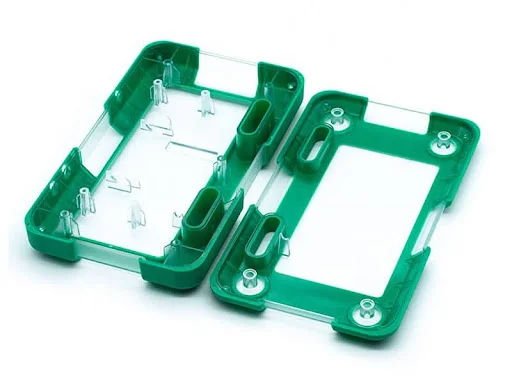Overmolding services introduce innovative techniques that have revolutionized the manufacturing landscape by combining different materials to improve product performance and design. The process involves molding one material onto another, often plastic over metal or plastic over plastic.
In this article, we will explore the methods employed in over-molding plastic and metal components, focusing on the common plastic and rubber materials used in this complex process.
What Is Overmolding?
Overmolding services, also known as two-shot molding or multi-material molding, is a specialized manufacturing process that involves molding one material over another to create a single, integrated product.
This method helps solve design problems by mixing different materials.
Overmolding isn’t just for certain material combos; it usually means molding plastic over metal or plastic over plastic.
The goal is to blend materials seamlessly, making a product that works well and looks good too.
Compared to regular products made of one material, over-molded ones are often stronger, more comfortable to use, and look nicer.
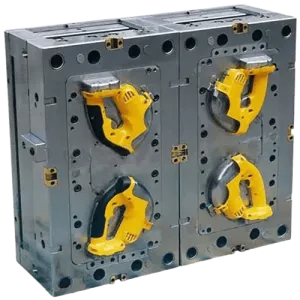
Advantages of Overmolding
Overmolding is really useful in lots of different industries because it has many advantages. Some important benefits are:
1. Enhanced Aesthetics
Overmolding helps add different colors, textures, and materials to make things look better. This is really useful for things people buy because how they look is really important.
2. Improved Ergonomics
Making soft, rubbery stuff fit snugly over hard parts makes things more comfy and easier to hold. You can notice this in how handles, grips, and other things you touch are shaped.
3. Increased Durability
Mixing different materials can make things stronger and better at taking hits. Overmolding strengthens important spots, making them less likely to get damaged or worn out when conditions are tough.
4. Cost-Effective Manufacturing
Overmolding makes manufacturing simpler by combining many parts into one. This saves money on making, putting together, and using materials.
5. Seamless Integration of Components
Overmolding mixes different materials together without needing extra steps to put them together. This makes the final product stronger because everything fits together smoothly.
Common Application Cases of Overmolding
Overmolding helps solve manufacturing problems in new ways across many industries.
Since 2002, Sung Precision Mould & Plastic Co., Ltd has provided top-notch plastic injection molds and services.
These include plastic injection molding, custom injection molding, prototype injection molding, over-molding, insert molding, and more.
We stand out in our industry because we use our technical knowledge of injection molding and materials, prioritize customer service and responsiveness, and focus on quality and reliability.
If your business needs a plastic mold manufacturer and injection molding supplier, please contact us with your inquiry for injection molded parts.
1. Consumer Electronics
Overmolding is used a lot in making things like phones, remote controls, and wearable gadgets. It helps makers create smooth designs, comfy grips, and stronger products.
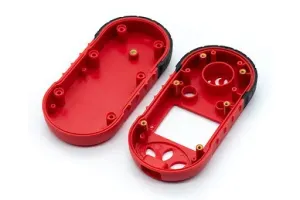 2. Medical Devices
2. Medical Devices
In medicine, over-molding is used to make comfy handles for surgery tools, easy-to-hold grips for medical devices, and parts that resist chemicals better.
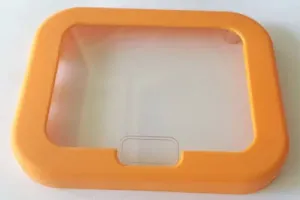 3. Automotive Components
3. Automotive Components
In the car industry, they use overmolding to make steering wheels, gear shift knobs, and handles feel soft. This makes driving more comfortable and makes the inside of the car look better.
4. Tool Handles and Grips
Tools with special handles are easier to hold and more comfortable to use. Manufacturers can make these handles fit nicely in your hand by using a process called over-molding.
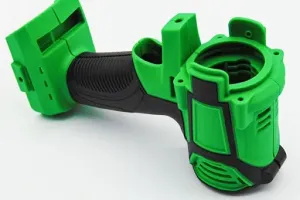
5. Industrial Equipment
Overmolding makes different parts of machines stronger and more durable. It also makes them more comfortable to use.
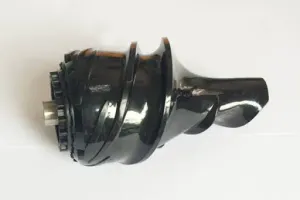
How to Overmold Plastic Parts?
Making over-molded plastic parts is a careful job that needs skill. Here are the basic steps for making them:
- Material Selection: Pick the right materials for the base and over-mold parts. Think about how well the materials stick together, how they handle heat changes, and how they work overall.
- Mold Design: Make molds for the base and over-mold parts. Make sure they fit together right when making the parts. The molds need to fit the shapes of the parts and let the material flow correctly.
- Insert Placement: When you use inserts (metal or plastic parts), put them in the mold with the main material. The inserts will be covered by the over-mold material when you make the mold.
- Injection Molding: First, we inject the base material into the mold. Then, we open the mold and inject the over-mold material on top of it. During this step, the over-mold material sticks to the base material.
- Cooling and Ejection: Let the mix cool and harden in the mold. After it cools, take out the part from the mold.
How to Overmold Metal Parts?
Making metal parts with overmolding is like making plastic parts with overmolding, but there are extra things to think about because metal and plastic are different.
- Material Compatibility: Ensure the metal part and the over-mold material work well together. This means addressing issues like how they expand with heat and how well they stick together.
- Surface Preparation: Get the metal part ready so it sticks well with the overmold stuff. You can put treatments or coatings on the surface to help it stick even better.
- Mold Design: Create molds that fit the metal part well and make sure they line up exactly with the overmold material. It’s important to think about how heat moves because metal and plastic cool at different speeds.
- Insert Placement: Position the metal part within the mold for the base material, taking care to ensure proper alignment. The metal part will be encapsulated by the mold material during the molding process.
- Injection Molding: First, inject the base material. Then, inject the overmold material. The overmold material sticks to the metal part when it’s being molded.
- Cooling and Ejection: Let the mixed part cool down and become hard inside the mold. After that, take out the metal part from the mold.
Common Plastic and Rubber Materials Used for Overmolding
Over-molding works well when you choose materials that stick together, are strong, and work well. Plastic and rubber are often used for over-molding.
Thermoplastic Elastomers (TPE)
TPEs are special materials that are a mix of rubber and plastic. They’re great because they’re bendy, soft, and last a long time. They’re good for covering things that need to feel nice or have a soft surface.
Thermoplastic Polyurethane (TPU)
TPU is a type of material that can stretch a lot and is tough against rubbing and chemicals. People often use it for making things like shoe soles and handles because it’s flexible and strong.
Liquid Silicone Rubber (LSR)
LSR is a flexible and heat-resistant material that can be over-molded onto various substrates, including plastic and metal. It is often used in medical devices, consumer electronics, and automotive components.
Polypropylene (PP)
PP is a common type of tough plastic that resists chemicals. It’s good for making things where you need a strong, stiff base and want to add more plastic on top.
Acrylonitrile Butadiene Styrene (ABS)
ABS is a type of plastic that can take a hit without breaking and stays in shape. It’s good for adding a hard layer to other things made of plastic.
Polyamide (Nylon)
Nylon is very strong and doesn’t wear out easily, so it’s good for making things that need to last a long time, like over-molded parts. People often use it in cars and machines.
Polycarbonate (PC)
PC is a see-through plastic that’s really strong. It’s used when you need things to be clear.
Overmolding is a fancy way to put different materials together to make things better. It makes products look and work better.
You can put plastic over metal or plastic over plastic using overmolding. It makes things look nicer, feel better, and last longer.

